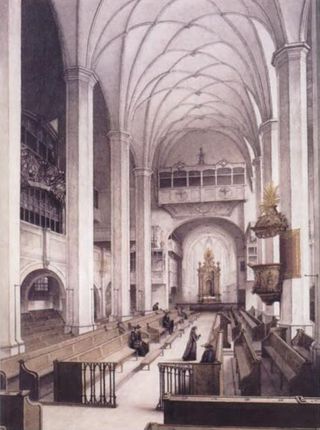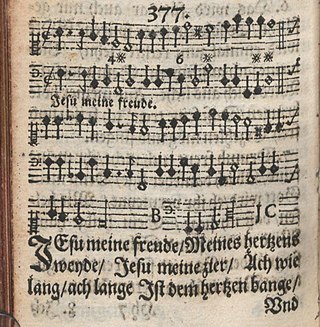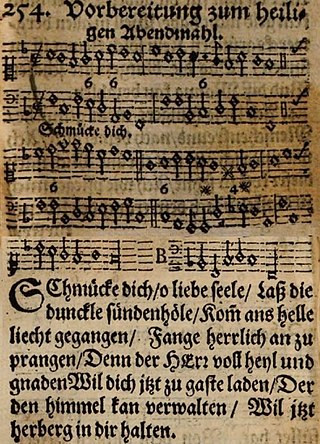
Johann Rist was a German poet and dramatist best known for his hymns, which inspired musical settings and have remained in hymnals.

Jesu, meine Freude, BWV 227, is a motet by Johann Sebastian Bach. The longest and most musically complex of Bach's motets, it is set in eleven movements for up to five voices. It is named after the Lutheran hymn "Jesu, meine Freude" with words by Johann Franck, first published in 1653. The motet contains the six stanzas of the hymn in its odd-numbered movements. The hymn tune by Johann Crüger appears in all of these movements in different styles of chorale settings. The text of the motet's even-numbered movements is taken from the eighth chapter of the Epistle to the Romans, a passage that influenced key Lutheran teachings. The hymn, written in the first person with a focus on an emotional bond with Jesus, forms a contrasting expansion of the doctrinal biblical text. Bach set both texts alternating with and complementing each other, in a structure of symmetries on different layers.

Jesu, der du meine Seele, BWV 78, is a church cantata by Johann Sebastian Bach. He composed it in Leipzig for the 14th Sunday after Trinity and first performed it on 10 September 1724. It is based on the 1641 hymn by Johann Rist, "Jesu, der du meine Seele", for which it is named. The topic of the chorale, the Passion of Jesus cleansing the believer, is only distantly related to the Sunday's readings.

"O Ewigkeit, du Donnerwort" is a Lutheran hymn in German, with text by Johann Rist, first published in Lüneburg in 1642. It was translated into English in several versions. The hymn was used in cantata music, including Bach's first chorale cantata of his second cantata cycle, BWV 20.

Johann Sebastian Bach composed the church cantata Allein zu dir, Herr Jesu Christ, BWV 33, in Leipzig in 1724 for the thirteenth Sunday after Trinity and first performed it on 3 September 1724. The chorale cantata is based on the 1540 hymn "Allein zu dir, Herr Jesu Christ" by Konrad Hubert.

"Gelobet seist du, Jesu Christ" is a Lutheran hymn, written by Martin Luther in 1524. It was first published in 1524 in the Eyn geystlich Gesangk Buchleyn. For centuries the chorale has been the prominent hymn (Hauptlied) for Christmas Day in German speaking Lutheranism, but has also been used in different translations internationally. It has appeared in hymnals of various denominations including the Catholic Church.

"Was willst du dich betrüben" is a hymn in seven stanzas by the German Baroque poet, Lutheran minister and hymn-writer Johann Heermann. The chorale was first published in 1630 during the Thirty Years' War. It is focused on trust in God, even when facing adversaries.

Johann Sebastian Bach composed the church cantata Was Gott tut, das ist wohlgetan, BWV 99, in Leipzig for the 15th Sunday after Trinity and first performed it on 17 September 1724. The chorale cantata is based on the hymn "Was Gott tut, das ist wohlgetan" by Samuel Rodigast (1674).
There are 52 chorale cantatas by Johann Sebastian Bach surviving in at least one complete version. Around 40 of these were composed during his second year as Thomaskantor in Leipzig, which started after Trinity Sunday 4 June 1724, and form the backbone of his chorale cantata cycle. The eldest known cantata by Bach, an early version of Christ lag in Todes Banden, BWV 4, presumably written in 1707, was a chorale cantata. The last chorale cantata he wrote in his second year in Leipzig was Wie schön leuchtet der Morgenstern, BWV 1, first performed on Palm Sunday, 25 March 1725. In the ten years after that he wrote at least a dozen further chorale cantatas and other cantatas that were added to his chorale cantata cycle.

Johann Sebastian Bach composed the church cantata Ach, lieben Christen, seid getrost, BWV 114, in Leipzig for the 17th Sunday after Trinity and first performed it on 1 October 1724. It is based on on a 1561 hymn of penitence by Johannes Gigas. Its tune is featured in three of the work's seven movements.

"Jesu, meine Freude" is a hymn in German, written by Johann Franck in 1650, with a melody, Zahn No. 8032, by Johann Crüger. The song first appeared in Crüger's hymnal Praxis pietatis melica in 1653. The text addresses Jesus as joy and support, versus enemies and the vanity of existence. The poetry is bar form, with irregular lines from 5 to 8 syllables. The melody repeats the first line as the last, framing each of the six stanzas.
"Werde munter, mein Gemüte" is a Lutheran evening hymn by Johann Rist, consisting of twelve stanzas with eight lines each, first printed in 1642. The hymn has been translated to English and appears in 67 hymnals.

"Schmücke dich, o liebe Seele" is a Lutheran hymn in German, with lyrics by Johann Franck and a hymn tune by Johann Crüger. It was first published in Crüger's 1649 Geistliche Kirchen-Melodien, and was later adopted in other hymnals, such as the 1653 edition of his Praxis pietatis melica.
"Herr Jesu Christ, du höchstes Gut" is the beginning of two Lutheran hymns. One is a penitential hymn, written in 1588 by Bartholomäus Ringwaldt, who possibly also created the melody. The other is an anonymous communion hymn, probably based on the former, which appeared first in 1713. Johann Sebastian Bach's used the penitential hymn several times, including the chorale cantata Herr Jesu Christ, du höchstes Gut, BWV 113, based on the hymn.
"Jesu Leiden, Pein und Tod" is a German Lutheran hymn by Paul Stockmann. Written in 34 stanzas and published in 1633, it narrates the Passion of Jesus. It was sung to a melody by Melchior Vulpius. Johann Sebastian Bach used three of its stanzas as chorales in his St John Passion.

"Christus, der uns selig macht" is a German Lutheran Passion hymn in eight stanzas in German by Michael Weiße, written in 1531 as a translation of the Latin hymn "Patris Sapientia" to an older melody of the Bohemian Brethren.
"Auf meinen lieben Gott" is a Lutheran hymn from the 17th century. Several hymns are sung to the same hymn tune, including "Wo soll ich fliehen hin", and it was set in compositions. The hymn was translated into English as "In God, My Faithful God". It is part of modern hymnals and songbooks.
"Ermuntre dich, mein schwacher Geist" is a German Christmas carol with lyrics by Johann Rist and a melody by Johann Schop, first published in 1641. Historically it was contained in Protestant hymnals, but the current one, Evangelisches Gesangbuch, uses only three of its stanzas, the ninth, the second and the twelfth, titled "Brich an, du schönes Morgenlicht". This stanza was used by Johann Sebastian Bach as a chorale in Part II of his 1734 Christmas Oratorio.

"Liebster Jesu, wir sind hier" is a Lutheran hymn with text written by Tobias Clausnitzer in 1663, and a hymn tune, Zahn No. 3498b, based on a 1664 melody by Johann Rudolph Ahle. A prayer for illumination, it is suitable for the opening of a church service and to be sung before a sermon. The song is part of the Protestant hymnal Evangelisches Gesangbuch as EG 161. It is also part of the Catholic hymnal Gotteslob as GL 149. It is popular also in English translations such as "Blessed Jesus, at your word" by Catherine Winkworth.
Jesu, meines Glaubens Zier is a German Lutheran hymn by Gottfried Wilhelm Sacer, first published in 1661. Its hymn tune, Zahn No. 6453, was first published in 1714, in Freylinghausen's hymnal. In 1736 the hymn was adopted in Schemellis Gesangbuch, with a figured bass accompaniment which may have been contributed by Johann Sebastian Bach (BWV 472).













